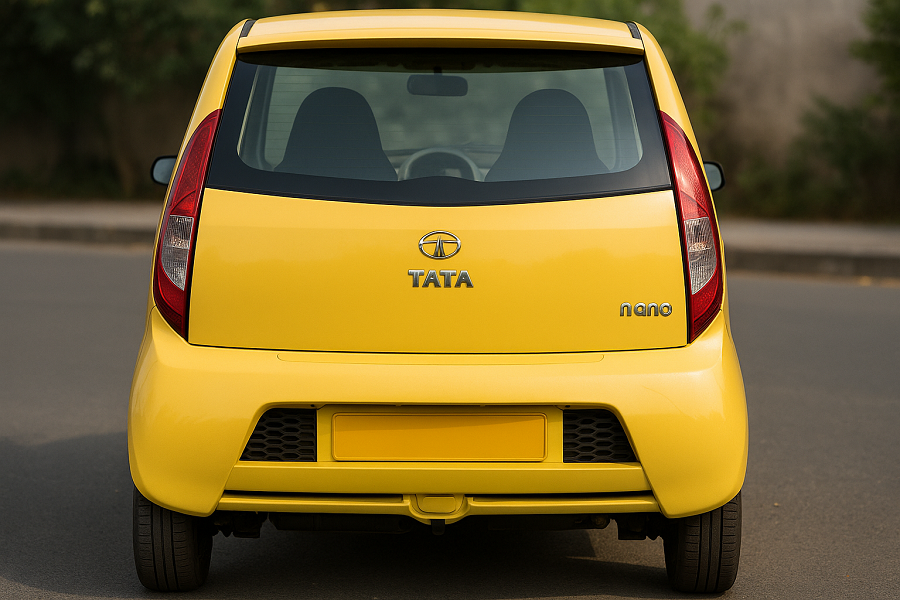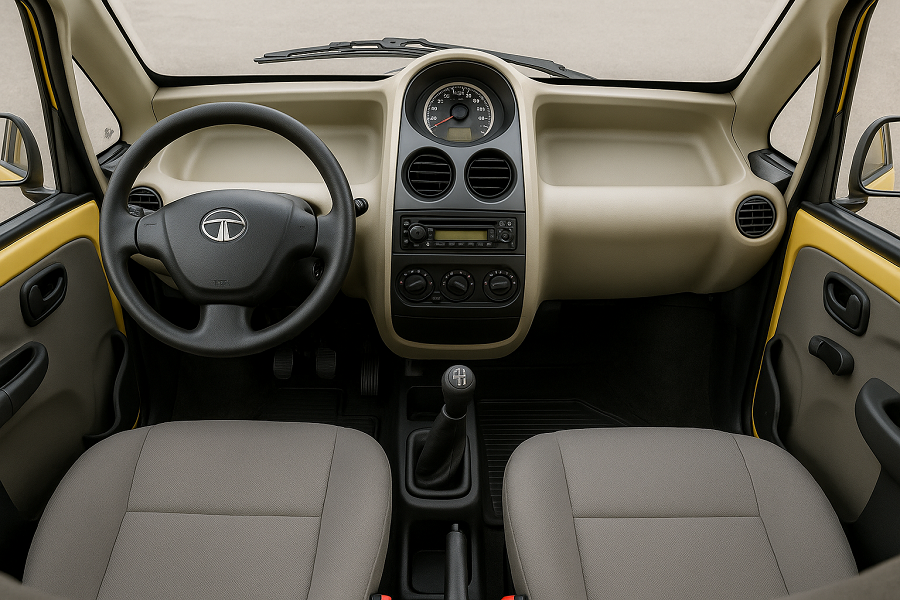The Tata Nano, often dubbed the “People’s Car,” holds a unique place in automotive history as the world’s cheapest production car at its launch in 2008. Priced at just ₹1 lakh (roughly $2,000 USD), it was a bold attempt by Tata Motors to make car ownership accessible to millions of Indian families who relied on two-wheelers for daily commuting. Spearheaded by visionary industrialist Ratan Tata, the Nano was more than a car—it was a symbol of ambition, innovation, and a commitment to social good.
Despite its revolutionary intent, the Nano’s journey was a rollercoaster of triumphs and challenges, leaving an indelible mark on the Indian automotive landscape and beyond. For automobile enthusiasts, the Tata Nano is a fascinating case study in frugal engineering, market dynamics, and the complexities of consumer perception. Let’s dive into the story of this iconic budget car in India, exploring its development, design, performance, and lasting legacy.
The Vision Behind the Tata Nano: A Dream Born on a Rainy Day
The Tata Nano wasn’t just a business venture; it was a personal mission for Ratan Tata, the former chairman of Tata Group. In the early 2000s, Ratan Tata witnessed a family of four precariously balanced on a scooter during a rainy day in India. The sight of parents and children exposed to the elements and traffic hazards sparked an idea: to create a safe, affordable, all-weather alternative to two-wheelers. This vision became the cornerstone of the Tata Nano project, aiming to democratize car ownership for India’s burgeoning middle class.
Development Background
- Inspiration (2003): Ratan Tata conceptualized the Nano after observing the unsafe conditions faced by families on scooters. Initially, the idea was to improve two-wheeler safety, but it evolved into a four-wheeler concept.
- Announcement (2006): Tata Motors announced plans for a ₹1 lakh car, grabbing global attention for its audacious price point.
- Challenges in Singur: The original manufacturing plant was planned in Singur, West Bengal, but faced fierce protests from farmers over land acquisition, led by political leader Mamata Banerjee. This forced Tata to relocate the plant to Sanand, Gujarat, delaying production and increasing costs.
- Launch (2008): The Nano was unveiled at the Delhi Auto Expo in January 2008, with commercial sales starting in 2009. The base model was priced at ₹1 lakh (ex-factory), though taxes and delivery charges pushed the on-road price higher.
Quick Fact: The Nano’s development took over five years, with a young design team averaging 25-26 years old, showcasing Tata’s faith in fresh talent to tackle this ambitious project.
Design and Engineering: A Marvel of Frugal Innovation
The Tata Nano was a triumph of frugal engineering, a term that became synonymous with Tata Motors’ ability to maximize functionality while minimizing costs. Its compact design and clever engineering made it a standout in the world of affordable Indian cars.
Key Design Features
- Compact Dimensions: Measuring just 3.1 meters long, 1.5 meters wide, and 1.6 meters tall, the Nano had the smallest footprint of any car in India, ideal for navigating crowded urban streets.
- Space Efficiency: Despite its tiny exterior, the Nano’s tallboy design and rear-mounted engine provided a surprisingly spacious cabin, comfortably seating four adults. It boasted 21% more interior space than the Maruti 800, its closest competitor.
- Minimalist Approach: To keep costs low, the Nano featured one wiper blade, a single side mirror (driver’s side), three lug nuts per wheel, and no fuel filler cap. These choices reduced material costs without compromising core functionality.
Engineering Highlights
- Rear-Mounted Engine: The Nano’s 624cc, two-cylinder, aluminum MPFI petrol engine was placed at the rear, driving the rear wheels. This layout freed up cabin space and lowered production costs.
- Lightweight Construction: At just 635 kg, the Nano’s lightweight body contributed to its impressive fuel efficiency and ease of handling.
- Innovative Components: The car used a single balancer shaft in its two-cylinder engine, a first for a production car, to reduce vibrations. The all-sheet metal body included crumple zones and intrusion-resistant doors to meet basic safety standards.
Tata Nano Specs Table
| Feature | Details |
|---|---|
| Engine | 624cc, 2-cylinder, petrol |
| Power | 35 PS @ 5,250 RPM |
| Torque | 48 Nm @ 3,000 RPM |
| Transmission | 4-speed manual, later 5-speed AMT |
| Top Speed | 105 km/h (electronically limited) |
| Mileage (ARAI) | 23.6–25.4 kmpl (petrol), 36 km/kg (CNG) |
| Ground Clearance | 180 mm |
| Turning Radius | 4 meters |
| Weight | 635–765 kg (depending on variant) |
Quick Fact: The Nano’s 4-meter turning radius made it exceptionally maneuverable, perfect for India’s chaotic city traffic.

Market Positioning and Pricing Strategy
The Tata Nano was marketed as the “world’s cheapest car,” a tagline that was both its greatest strength and its Achilles’ heel. Ratan Tata’s goal was to offer a vehicle priced at ₹1 lakh, making it only slightly more expensive than a premium two-wheeler. This pricing strategy aimed to attract first-time car buyers, particularly those upgrading from scooters or motorcycles.
- Initial Pricing: The base model launched at ₹1 lakh (ex-factory), but taxes, transportation, and dealer margins pushed the on-road price to around ₹1.4–1.5 lakh. By 2017, prices for higher variants reached ₹2.36–3.35 lakh due to rising material costs and added features.
- Target Audience: The Nano targeted lower-middle-class families and urban commuters looking for an affordable, fuel-efficient alternative to two-wheelers.
- Marketing Misstep: Labeling the Nano as the “cheapest car” backfired. In status-conscious India, the term “cheap” implied low quality, deterring aspirational buyers who viewed cars as status symbols. Ratan Tata later admitted that marketing it as “affordable” rather than “cheap” could have changed its fate.
Performance, Mileage, and Variants
The Tata Nano was designed for efficiency and practicality, not speed. Its modest performance suited its role as a city car, while its mileage made it a budget-friendly option.
Performance Specs
- Engine Output: The 624cc engine produced 35 PS and 48 Nm, adequate for city driving but underpowered for highways. The top speed was limited to 105 km/h, with 0–60 km/h taking around 35 seconds.
- Handling: The Nano’s high ground clearance (180 mm) and tight turning radius made it agile in urban settings, though its lightweight build led to body roll and instability at higher speeds.
- Driving Experience: Enthusiasts noted its smooth handling in city traffic but criticized its bumpy ride and lack of power for long drives.
Mileage
The Nano’s fuel efficiency was a major selling point:
- Petrol Variants: ARAI-certified mileage ranged from 23.6 to 25.4 kmpl, with real-world figures around 18–22 kmpl.
- CNG Variants: The Nano eMax offered up to 36 km/kg, making it one of the most economical cars in its segment.
Variants
The Nano evolved over its decade-long run, with Tata introducing new variants to address consumer demands:
- Nano CX/LX (2009): Base and mid-level models with minimal features.
- Nano Twist (2014): Added power steering and improved interiors.
- Nano GenX (2015): Introduced a 5-speed AMT (automated manual transmission), openable boot, and features like air conditioning and power windows.
Quick Fact: The Nano’s CNG variant was a game-changer for budget-conscious buyers, offering unmatched running costs for urban commuters.
Notable Features and Innovations
The Tata Nano was a showcase of innovative engineering tailored to its price point:
- Space Optimization: The rear-engine layout and tallboy design maximized cabin space, making it surprisingly roomy for a car of its size.
- Fuel Efficiency: Its lightweight construction and efficient engine made it one of the most fuel-efficient petrol cars in India at the time.
- Low Maintenance: With fewer components and a simple design, the Nano was cheaper to maintain than most rivals.
- Safety Features: While basic, it included crumple zones, seat belts, and intrusion-resistant doors, though it lacked airbags and ABS, leading to criticism.
- AMT Introduction: The GenX Nano’s automated manual transmission was a segment-first, offering clutchless driving at a budget price.
Public Reception, Criticism, and Controversies
The Tata Nano generated immense buzz at its 2008 unveiling, with global media comparing it to the Ford Model T and Volkswagen Beetle for its potential to transform mobility. However, its reception was mixed, and controversies plagued its journey.
Public Reception
- Initial Hype: The Nano’s ₹1 lakh price tag drew over 200,000 bookings in 2009, signaling strong initial demand.
- Declining Sales: Sales peaked at around 70,000 units annually in the first two years but dropped to just 7,591 units by 2016–17, far below Tata’s target of 250,000 units per year.
- Consumer Feedback: Owners praised its affordability, fuel efficiency, and ease of parking but criticized its lack of power, basic features, and perceived low quality.
Criticisms and Controversies
- Safety Concerns: In 2014, Global NCAP crash tests gave the Nano zero stars for adult and child occupant protection, citing an unstable passenger compartment and lack of airbags. Early reports of Nanos catching fire due to faulty electrical wiring further damaged its reputation.
- Singur Protests: The land acquisition controversy in Singur delayed production and tarnished Tata’s image, with farmers and activists opposing the plant’s establishment.
- Marketing Blunder: The “cheapest car” label created a stigma, making the Nano less appealing to aspirational buyers who preferred second-hand sedans or larger hatchbacks.

Why Did the Tata Nano Fail? An Enthusiast’s Perspective
From an enthusiast’s perspective, the Tata Nano’s failure wasn’t due to engineering shortcomings but a mix of market missteps and societal factors:
- Misaligned Marketing: The “cheapest car” tag alienated buyers who saw cars as status symbols. Positioning it as a “smart, affordable city car” could have resonated better.
- Evolving Consumer Preferences: By 2009, India’s middle class was gravitating toward feature-rich hatchbacks like the Maruti Alto and Hyundai Eon, which offered air conditioning, power steering, and better aesthetics.
- Safety and Quality Perceptions: Reports of fires and poor crash test results fueled perceptions of the Nano as unsafe and low-quality, despite Tata’s efforts to address these issues.
- Production Challenges: The Singur controversy delayed the Nano’s rollout, allowing competitors to capture market share. Rising material costs also pushed prices beyond the ₹1 lakh promise.
Yet, the Nano wasn’t a complete failure. It achieved its goal of proving that a functional car could be built at an unprecedented price, inspiring global automakers to explore low-cost models. Enthusiasts admire its bold engineering and Ratan Tata’s vision, even if commercial success eluded it.
Legacy and Current Relevance in Auto Culture
The Tata Nano’s legacy is multifaceted, blending innovation, ambition, and lessons in market dynamics:
- Frugal Engineering Blueprint: The Nano showcased India’s ability to innovate under constraints, influencing global automakers to develop budget cars for emerging markets.
- Cultural Icon: Despite its commercial struggles, the Nano remains a collectible for enthusiasts, with some calling it a future classic due to its unique place in history.
- Electric Future? Rumors of a Tata Nano EV persist, with a retrofitted electric version developed by Electra EV owned by Ratan Tata himself. While no official launch has been confirmed, a Nano EV could revive the “people’s car” concept in India’s growing electric vehicle market.
Quick Fact: The Nano inspired global discussions on affordable mobility, with publications like Jalopnik praising its “man-maximum, machine-minimum” philosophy.
Comparison with Other Budget Cars
| Car Model | Price Range (2017) | Engine | Mileage (ARAI) | Key Features |
|---|---|---|---|---|
| Tata Nano | ₹2.05–3.35 Lakh | 624cc, 35 PS | 23.6–25.4 kmpl | Compact, AMT, high ground clearance |
| Maruti Alto 800 | ₹2.5–4.0 Lakh | 796cc, 48 PS | 22.7–24.7 kmpl | Airbags, ABS, better power |
| Hyundai Eon | ₹3.0–4.7 Lakh | 814cc, 56 PS | 21.1 kmpl | Modern design, feature-rich |
| Datsun redi-GO | ₹2.5–4.3 Lakh | 799cc, 54 PS | 22.7 kmpl | Stylish, higher power output |
The Nano was unmatched in price but lagged in power and features compared to rivals like the Maruti Alto 800, which offered airbags and ABS, or the Hyundai Eon, with its modern design. Enthusiasts appreciated the Nano’s simplicity but found competitors more appealing for highway driving and comfort.
Conclusion: The Tata Nano’s Enduring Story
The Tata Nano was a bold experiment in affordable mobility, driven by Ratan Tata’s vision to make car ownership a reality for millions. While it didn’t achieve the commercial success hoped for, its impact on Indian and global automotive culture is undeniable. For enthusiasts, the Nano is a testament to what’s possible when innovation meets ambition, even if market realities pose challenges. Its compact design, impressive mileage, and frugal engineering continue to spark conversations, and rumors of a Tata Nano EV keep its spirit alive. Whether you see it as a quirky city car or a revolutionary misstep, the Nano’s story is one of daring to dream big—a true icon in the world of affordable Indian cars.


